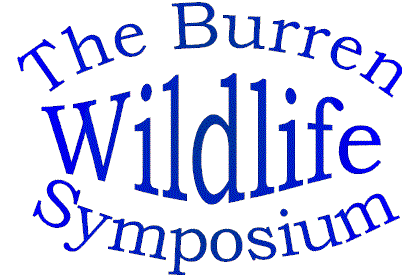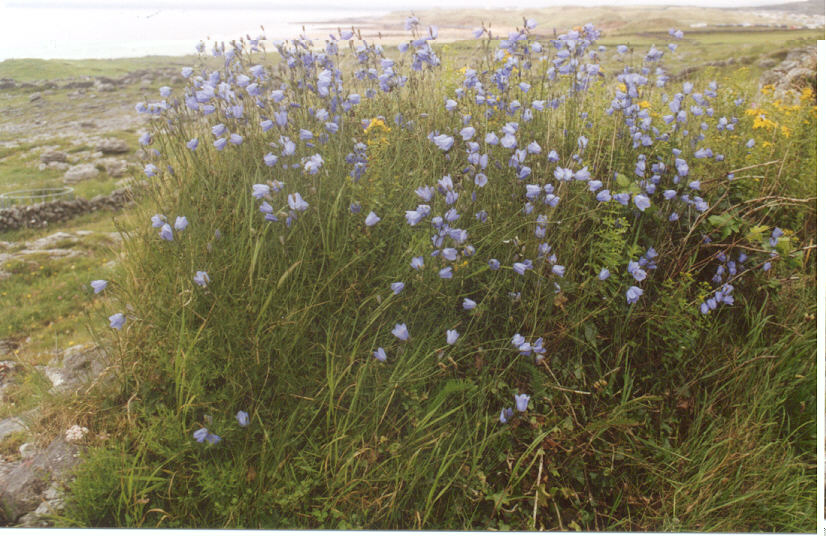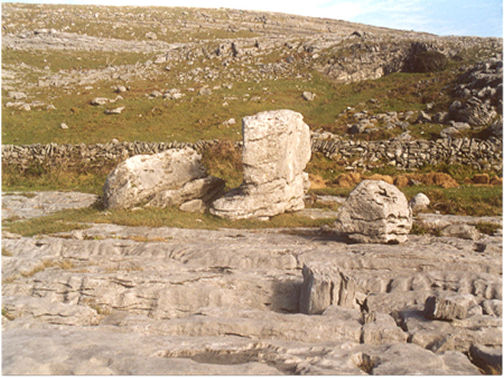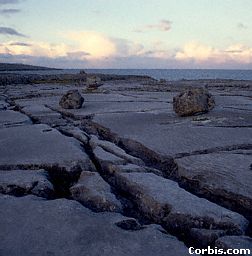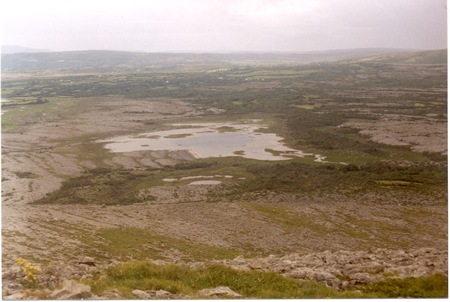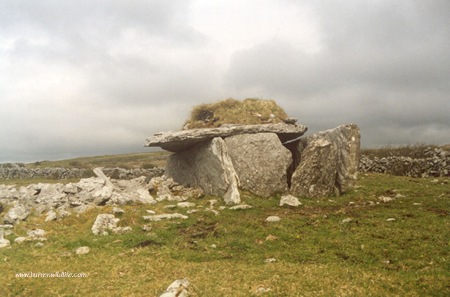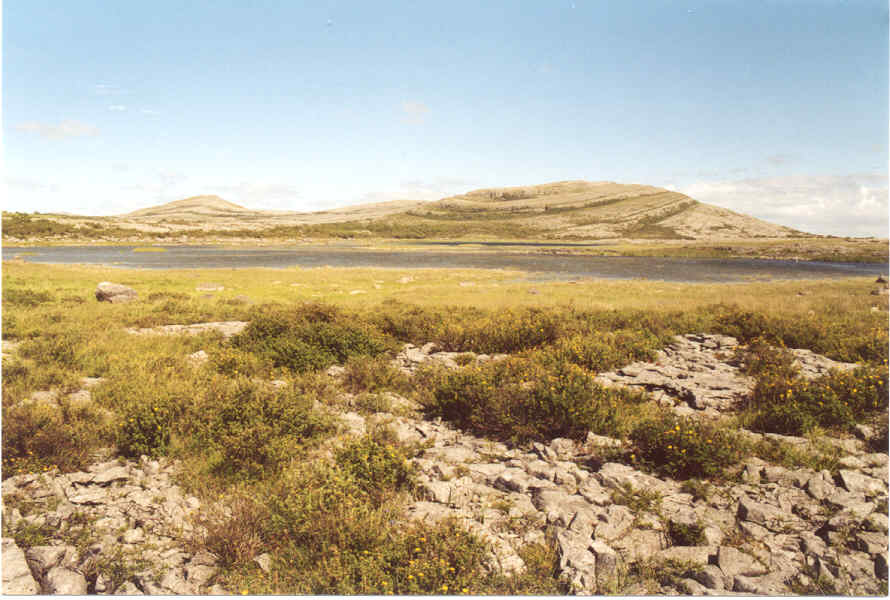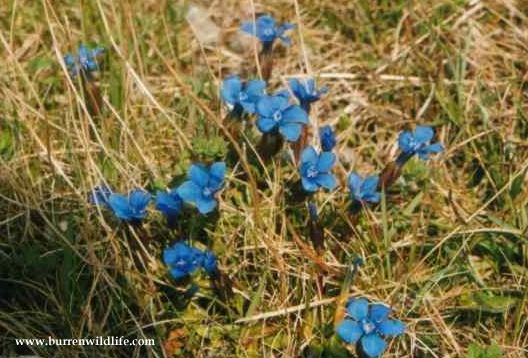Links: click on underlined words or text to navigate the page.
|
|
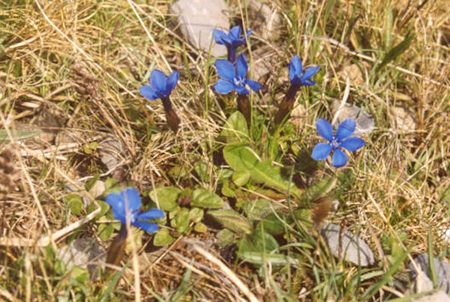 |
|||
This is the webpage of the Burren Wildlife Symposium. We are a voluntary educational group made up of amateur enthusiasts, and our aim is to increase awareness and appreciation of the Burren, in County Clare, Ireland. Please scroll down our page, to learn a little about the Burren and find out what we do. |
|||||
|
|
||||
These are glacial erratics; large boulders left behind by melting glaciers, here on flat glaciated rock pavement near Fanore. Much can be learnt from studying these deceptively simple features - our symposia always include walking trips with expert guides who will interpret the landscape and the features found on it.
The Burren national Park area around Mullaghmore is one of Europe's most significant unspoilt landscapes - here we see Loch Geallain from ground level (right) and from the peak of Mullaghmore (above). |
Man has left his marks on the Burren - the hundreds of miles of dry stone walls, easily overlooked or taken for granted, are proven to have been in existence for thousands of years in some cases, yet it is the sculpture of the glaciers, a mere 10,000 years ago, that uniquely defines this landscape.
Walls are the simplest man-made monuments: castles from the past centuries are found throughout the Burren, and their strategic fore-runners, the cahers, caiseals or stone ring forts are so common here as to be taken for granted.
Older monuments from pre-historic times like this dolmen at Parkbinna, speak of a lost culture; a stone-age society capable of honouring their dead with tombs that have endured for over 5,000 years. There are hundreds of these enigmatic structures in the Burren, some dramatically sited on prominent hilltops, others in secluded valleys. Archaeological discoveries are still being made, revealing the artefacts of those distant times.
|
||||
|
April 2005 Pat MacNamara's Photographs of Ivy Broomrape and White Gentians List of moth species identified in the Caher valley in August 2001
|
Wildlife has been a central theme of our symposia, and we always ensure that our guests see as much wildlife as possible over the weekends. What is rare elsewhere is frequently easily seen in the Burren; among the mammals we have pine martens, stoats, foxes, badgers, otters, seals, dolphins, and porpoises.
(Gentiana verna - Spring gentian) |
The Burren is celebrated as a birdwatchers mecca, attracting migrants and vagrants- the rarest birds have been seen here, including glaucus gulls, one record of an American Belted Kingfisher, occasional Ospreys and similar birds. The high cliffs and old buildings provide nest sites for kestrels and peregrine falcons, and one of our activities has been to safeguard these sites as far as possible. Next Event: The 34nd Burren Wildlife Symposium O'Donoghue's Hall, Fanore May 2005 - details uploaded on www.burrenwildlife.com |
|||
| Adrian Glasgow's pictures promises, promises...JC |
Flora - the flowers of the Burren have attracted visitors for centuries. The heady mix of alpine and arctic rarities is unique: our spring symposium takes full advantage of the best viewing time, and walks with expert guides are a feature. To minimise accidental damage to the rarest, we refrain from taking large groups on flora walks. |
Bloody Geranium and Mountain Aven. |
|||
| Accommodation There is a wide range of approved accommodation available to suit all budgets, including camping facilities, self-catering cottages, bed-and-breakfast guesthouses and several modern hotels. Contact the Burren Wildlife Symposium Secretary, Fanore, via Galway, Co. Clare, Ireland or alternatively e-mail us using this link, and we will be happy to advise you on your needs. - pre-booking is advisable, and a small deposit will usually be required |
Finding us: From overseas: flight to Shannon (45 mins away)or Dublin (2 hrs) or Galway (1 hr) Airports; car hire readily available. Car ferries operate from the UK. Ireland & Great Britain: get a route from www.rac.co.uk giving directions and approximate journey times. Set Lisdoonvarna as your destination if using Southern Ports: set Ballyvaughan if travelling through Dun Laoghaire, Dublin or northern ports. Our symposium takes place in O'Donoghue's Hall, Fanore on the Ballyvaughan to Lisdoonvarna coast road. It's adjacent to a conspicuous big blue pub. The Symposium Secretary's office is in the Admiral's Rest, Fanore. |
||||
We keep in touch using a discussion list. It is hosted on www.topica.com which we use to keep in touch with Symposium friends, and to make any interesting announcements relating to the Burren, or the Symposium. Postings are infrequent, so you will not be 'spammed'. Many of these links will open new windows, so that you can still read the remainder of this site. If you get lost, use your Browser's 'BACK' button to get back here.
|
Organisers: John Considine - 32 years of Burren study, particularly interested in badgers and foxes, and wildlife photography. Email John C. here: Adrian Glasgow - leading wildlife and landscape photographer; email Adrian here: Catriona Carroll, Kilshanny and Fanore - niece of John D. |
||||
|
The site is designed primarily for Microsoft Explorer, and a font called 'Technical' will look best. |
|||||
| Thanks for visiting our site - now visit the Burren, and come see us! | |||||
